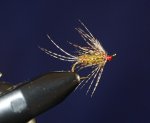Naturally, game bird such as partridge hackle has been employed by fly tiers...forever. Likely codified by Border County anglers in northern England sand southern Scotland in the 19th century with flies like partridge and olive, they early on became popular on our side of the pond and where what was most commonly fished by anglers traveling up from New York City to the famed waters of the Beaverkill and Willowemoc in the 1800's. This change a lot when Theodore Gordon, frustrated by lack of imitative flies for the abundant floating mayflies he experienced on his home Neversink as well as the Beomoc, developed a correspondence with famed chalkstream expert, Frederick Halford in London. Halford's remarkable upright winged mayfly imitations transformed Gordon and American anglers perspectives on trout flies. Note that Gordon's famous Quill Gordon was, unlike today, tied in various sizes and suggestive colors for all Catskill mayflies not just Epeorus pleuralis. Further understand that the dry fly hackle Gordon, Steenrod and the rest had available was nothing like the stiff "genetic" hackle available post Harry Darby and common place today. I digress. Wet flies took a different direction here as men like Ray Bergman favored colorful married wings with soft hackled beards. But during the Match the Hatch revolution, sparse soft ahckles reemnrged to suggest mayfly emergers. Mike Lawson's popular and effective Green Drake Emerger is basically a winged and ribbed soft hackle. I prefer barred partridge hackle to popular Zelon type synthetics for shucks and legs on half and half type Quigley style flies.
Leisenring, as Dillon suggested, fished his Flymphs upstream to a riser and failing an eat, mended slack to dead drift the soft hackle parallel to him then allowing it to sink and, swinging below, performed the Liesenring Lift by raising his rod tip and swimming the fly to the surface...for all the world like an emerging caddis.
To dress soft hackles to suggest crippled duns or spinners, I recommend a liquid silicone penetrating preparation such as Muscilin Liquid Silicone...it floats hackled flies very well without clumping fibers as might gel or surely past consistency floatants.




